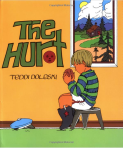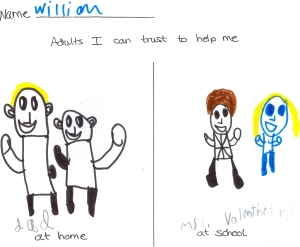 What happens when you keep your hurt feelings bottled up inside? The hurt deepens and festers. It gets bigger. This is the premise of The Hurt by Teddy Doleski. When Justin gets called a name, he doesn’t tell his friend how he feels or tell his dad what happened. Instead he just sits with his hurt, which looks like a rock, feeding it with his worries and disappointments until it gets so big that it takes up his whole room. The hurt finally starts to shrink and eventually goes away when Justin talks to his dad about it. The Hurt is a great book to share with individuals, in small groups, and in the classroom. It provides a great visual illustration about how uncomfortable feelings can grow (and shrink) and exert an almost physical pressure when not addressed. It shows very clearly how talking about difficult feelings can help alleviate the discomfort they are causing.
What happens when you keep your hurt feelings bottled up inside? The hurt deepens and festers. It gets bigger. This is the premise of The Hurt by Teddy Doleski. When Justin gets called a name, he doesn’t tell his friend how he feels or tell his dad what happened. Instead he just sits with his hurt, which looks like a rock, feeding it with his worries and disappointments until it gets so big that it takes up his whole room. The hurt finally starts to shrink and eventually goes away when Justin talks to his dad about it. The Hurt is a great book to share with individuals, in small groups, and in the classroom. It provides a great visual illustration about how uncomfortable feelings can grow (and shrink) and exert an almost physical pressure when not addressed. It shows very clearly how talking about difficult feelings can help alleviate the discomfort they are causing.
I use The Hurt at the beginning of my first grade unit on personal safety as a way to focus on and highlight the importance of telling, before we add in the more complex topics of safety, uncomfortable touch, and private parts. When we’re covering those topics, and talking about telling a trusted adult if something scary, unpleasant, or yucky happens, the kids, thanks to The Hurt, are able to explain (and show with their hands) how uncomfortable feelings will grow and grow unless they tell. The Hurt could also be used in second and third grade classrooms, and with older kids in smaller settings. I refer back to it with kids all the way through fifth grade when we’re talking about how unexpressed feelings can become overpowering.
Here’s an example of the paper first graders do after we read and discuss The Hurt:
You might also be interested in:
First Grade Lessons for Sexual Abuse Prevention


Trackbacks/Pingbacks